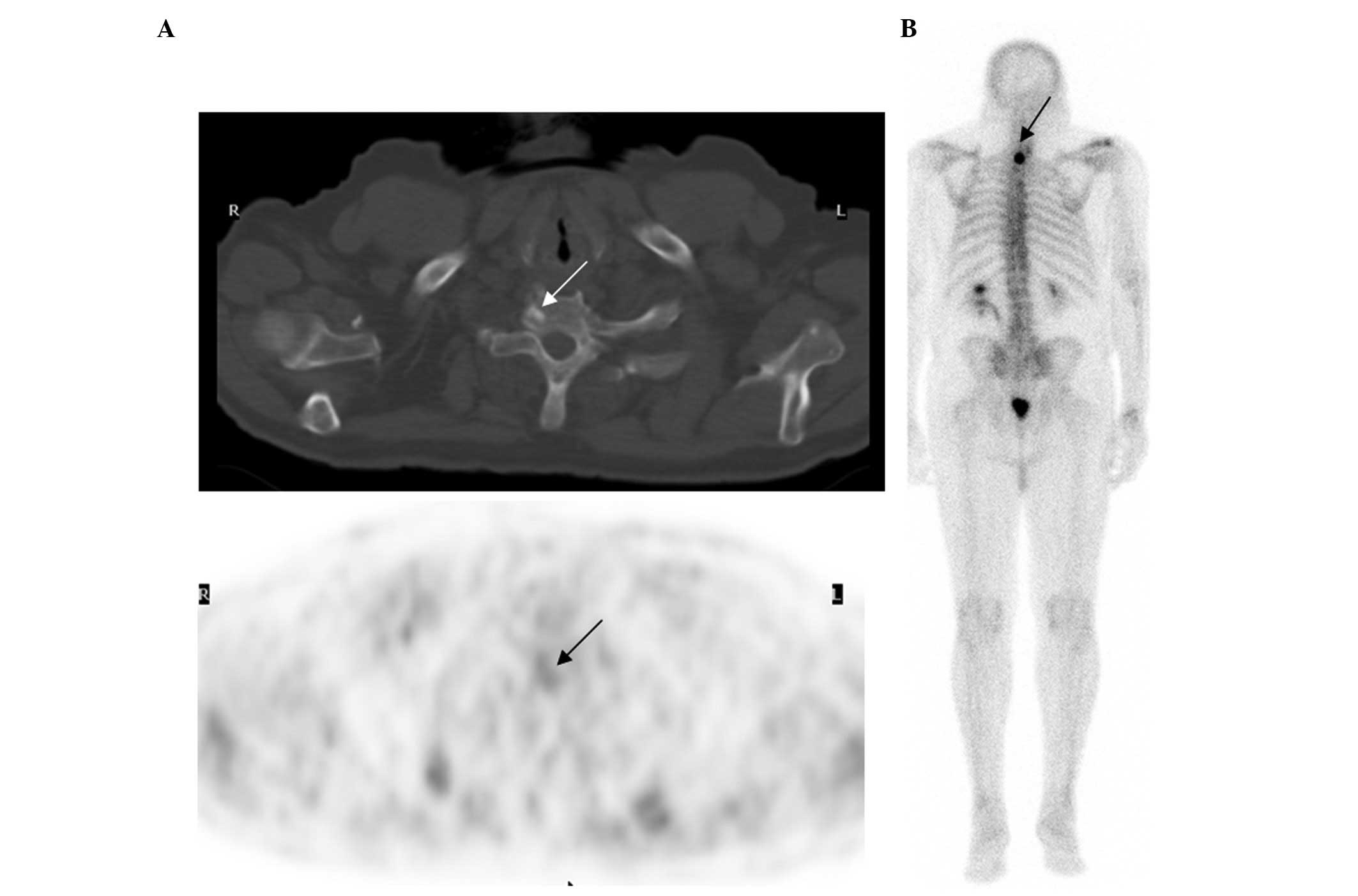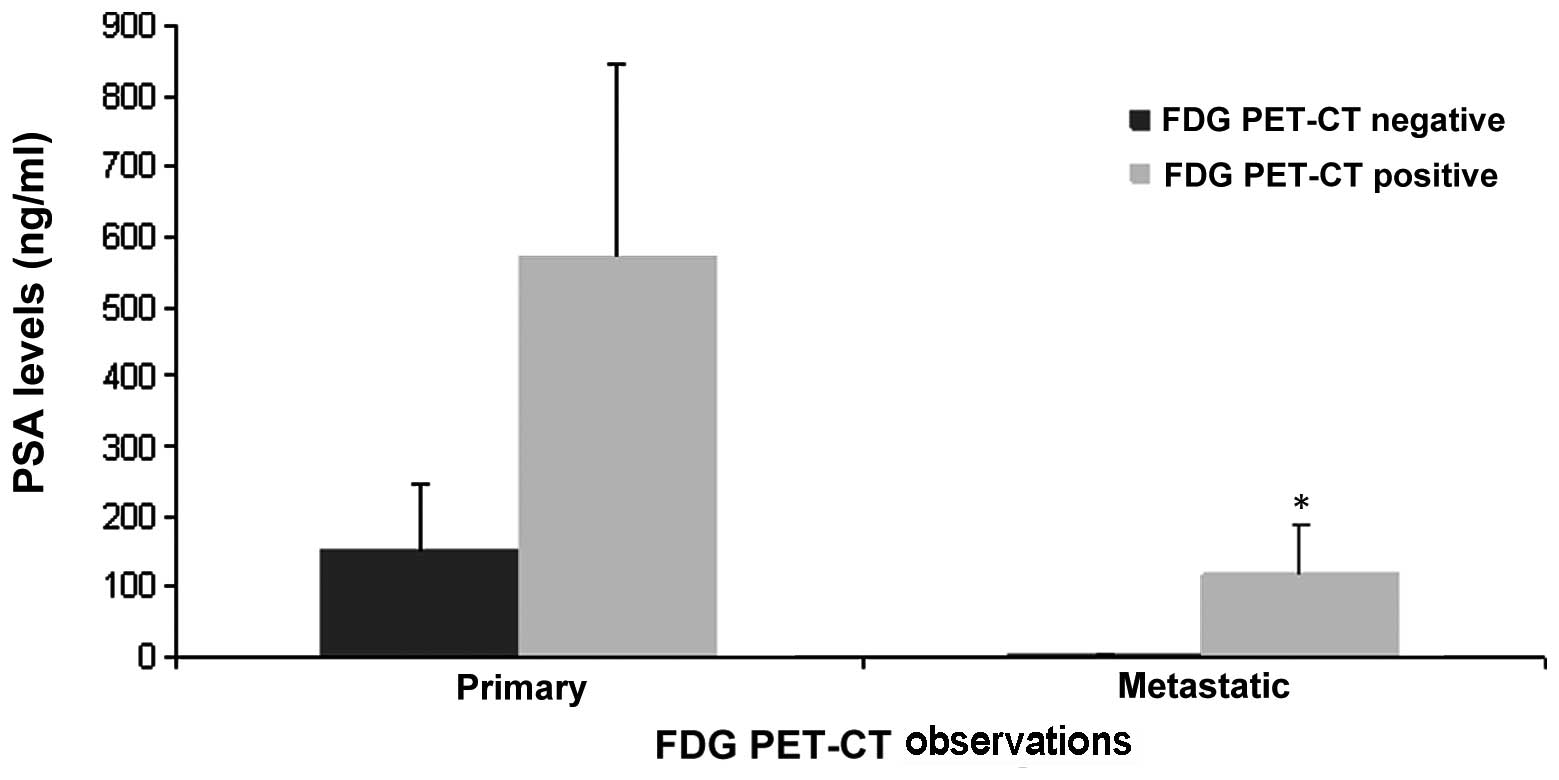|
1
|
Ravizzini G, Turkbey B, Kurdziel K and
Choyke PL: New horizons in prostate cancer imaging. Eur J Radiol.
70:212–226. 2009. View Article : Google Scholar : PubMed/NCBI
|
|
2
|
Powels T, Murray I, Brock C, Oliver T and
Avril N: Molecular positron emission tomography and PET/CT imaging
in urological malignancies. Eur Urol. 51:1520–1521. 2007.
View Article : Google Scholar : PubMed/NCBI
|
|
3
|
Lawrentschuk N, Davis ID, Bolton DM and
Scott AM: Positron emission tomography and molecular imaging of the
prostate: an update. BJU Int. 97:923–931. 2006. View Article : Google Scholar : PubMed/NCBI
|
|
4
|
Effert PJ, Bares R, Handt S, Wolff JM,
Büll U and Jakse G: Metabolic imaging of untreated prostate cancer
by positron emission tomography with 18fluorine-labeled
deoxyglucose. J Urol. 155:994–998. 1996. View Article : Google Scholar
|
|
5
|
Kapoor V, McCook BM and Torok FS: An
introduction to PET-CT imaging. Radiographics. 24:523–543. 2004.
View Article : Google Scholar : PubMed/NCBI
|
|
6
|
Liu Y, Ghesani NV and Zuckier LS:
Physiology and pathophysiology of incidental findings detected on
FDG-PET scintigraphy. Semin Nucl Med. 40:294–315. 2010. View Article : Google Scholar : PubMed/NCBI
|
|
7
|
Hofer C, Laubenbacher C, Block T, Breul J,
Hartung R and Schwaiger M: Fluorine-18-fluorodeoxyglucose positron
emission tomography is useless for the detection of local
recurrence after radical prostatectomy. Eur Urol. 36:31–35. 1999.
View Article : Google Scholar
|
|
8
|
Oyama N, Akino H, Suzuki Y, Kanamaru H,
Sadato N, Yonekura Y and Okada K: The increased accumulation of
[18F]-fluorodeoxyglucose in untreated prostate cancer. Jpn J Clin
Oncol. 29:623–629. 1999.
|
|
9
|
Liu IJ, Zafar MB, Lai YH, Segall GM and
Terris MK: Fluorodeoxyglucose positron emission tomography studies
in diagnosis and staging of clinically organ-confined prostate
cancer. Urology. 57:108–111. 2001. View Article : Google Scholar : PubMed/NCBI
|
|
10
|
Minamimoto R, Uemura H, Sano F, Terao H,
Nagashima Y, Yamanaka S, Shizukuishi K, Tateishi U, Kubota Y and
Inoue T: The potential of FDG-PET/CT for detecting prostate cancer
in patients with an elevated serum PSA level. Ann Nucl Med.
25:21–27. 2011. View Article : Google Scholar : PubMed/NCBI
|
|
11
|
Candler JD, Williams ED, Slavin JL, Best
JD and Rogers S: Expression and localization of GLUT1 and GLUT12 in
prostate carcinoma. Cancer. 97:2035–2042. 2003. View Article : Google Scholar : PubMed/NCBI
|
|
12
|
Singh G, Lakkis CL, Laucirica R and Epner
DE: Regulation of prostate cell division by glucose. J Cell
Physiol. 180:431–438. 1999. View Article : Google Scholar : PubMed/NCBI
|
|
13
|
Liu Y, Zuckier LS and Ghesani NV: Dominant
uptake of fatty acid over glucose by prostate cells: a potential
new diagnostic and therapeutic approach. Anticancer Res.
30:369–374. 2010.PubMed/NCBI
|
|
14
|
Heicappell R, Müller-Mattheis V, Reinhardt
M, Vosberg H, Gerharz CD, Müller-Gärtner H and Ackermann R: Staging
of pelvic lymph nodes in neoplasms of the bladder and prostate by
positron emission tomography with 2-[(18)F]-2-deoxy-D-glucose. Eur
Urol. 36:582–587. 1999.
|
|
15
|
Chang CH, Wu HC, Tsai JJ, Shen YY,
Changlai SP and Kao A: Detecting metastatic pelvic lymph nodes by
18F-2-deoxyglucose positron emission tomography in patients with
prostate-specific antigen relapse after treatment for localized
prostate cancer. Urol Int. 70:311–315. 2003. View Article : Google Scholar
|
|
16
|
Schöder H, Herrmann K, Gönen M, Hricak H,
Eberhard S, Scardino P, Scher HI and Larson SM:
2-[18F]fluororo-2-deoxyglucose positron emission tomography for the
detection of disease in patients with prostatic-specific antigen
relapse after radical prostatectomy. Clin Cancer Res. 11:4761–4769.
2005.
|
|
17
|
Effert P, Beniers AJ, Tamimi Y, Hardt S
and Jakse G: Expression of glucose transporter 1 (Glut-1) in cell
lines and clinical specimens from human prostate adenocarcinoma.
Anticancer Res. 24:3057–3063. 2004.PubMed/NCBI
|
|
18
|
Shiiba M, Ishihara K, Kimura G, Kuwako T,
Yoshihara H, Sato H, Kondo Y, Tsuchiya S and Kumita S: Evaluation
of primary prostate cancer using 11C-methionine-PET/CT and
18F-FDG-PET/CT. Ann Nucl Med. 26:138–145. 2012. View Article : Google Scholar : PubMed/NCBI
|
|
19
|
Jadvar H: Prostate cancer. Methods Mol
Biol. 727:265–290. 2011. View Article : Google Scholar
|
|
20
|
Bouchelouche K, Tagawa ST, Glodsmith SJ,
Turkbey B, Capala J and Choyke P: PET/CT imaging and
radioimmunotherapy of prostate cancer. Semin Nucl Med. 41:29–44.
2011. View Article : Google Scholar : PubMed/NCBI
|

















